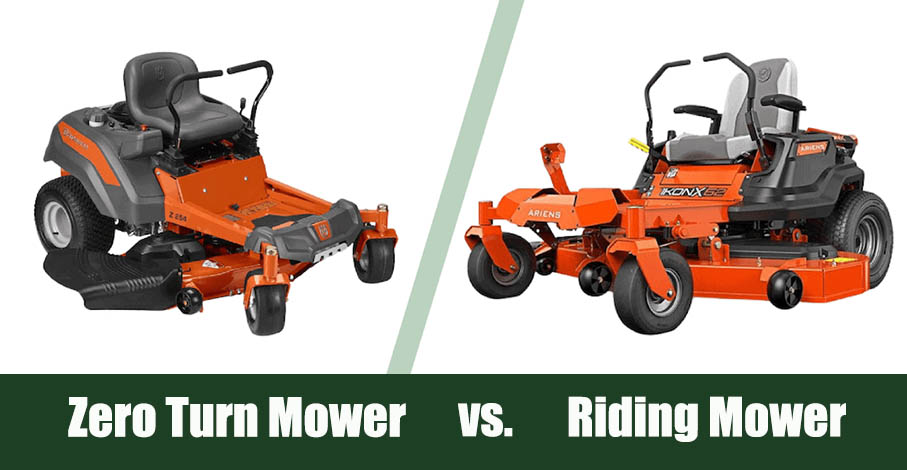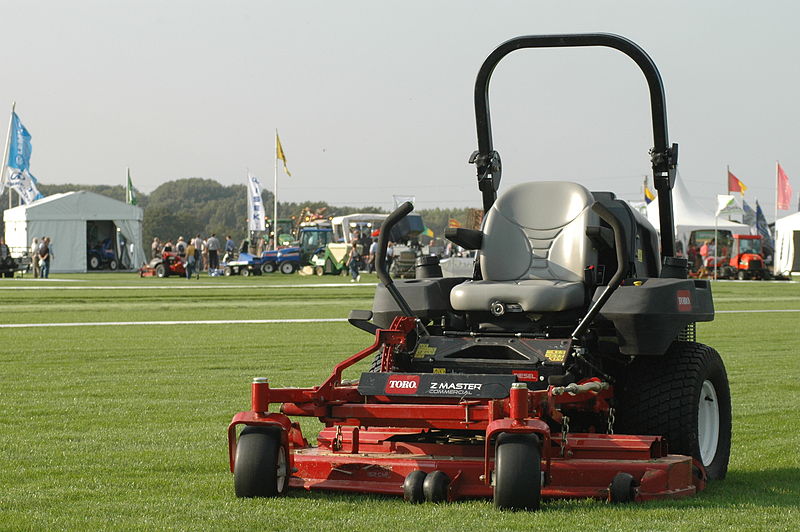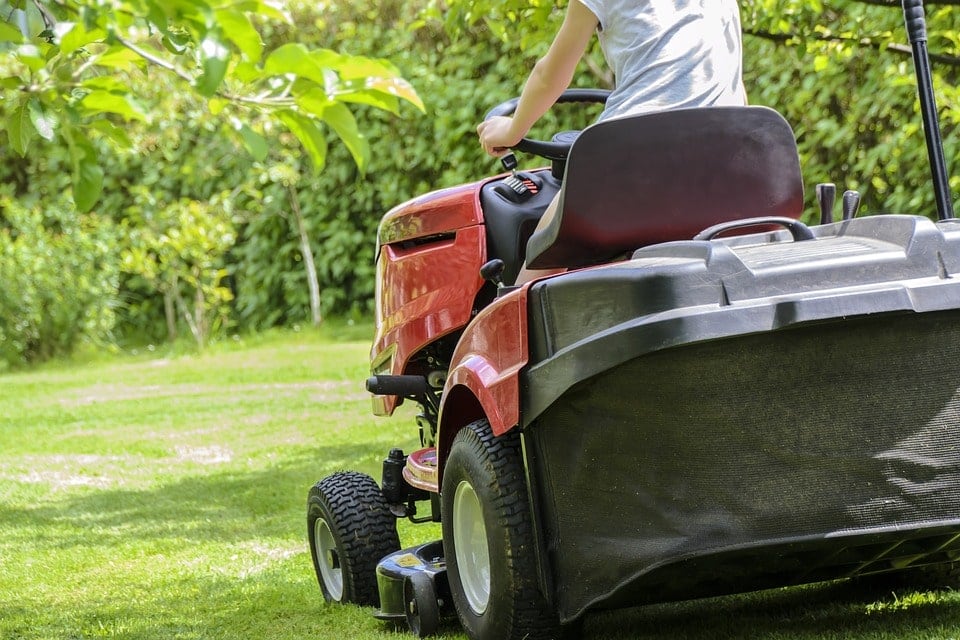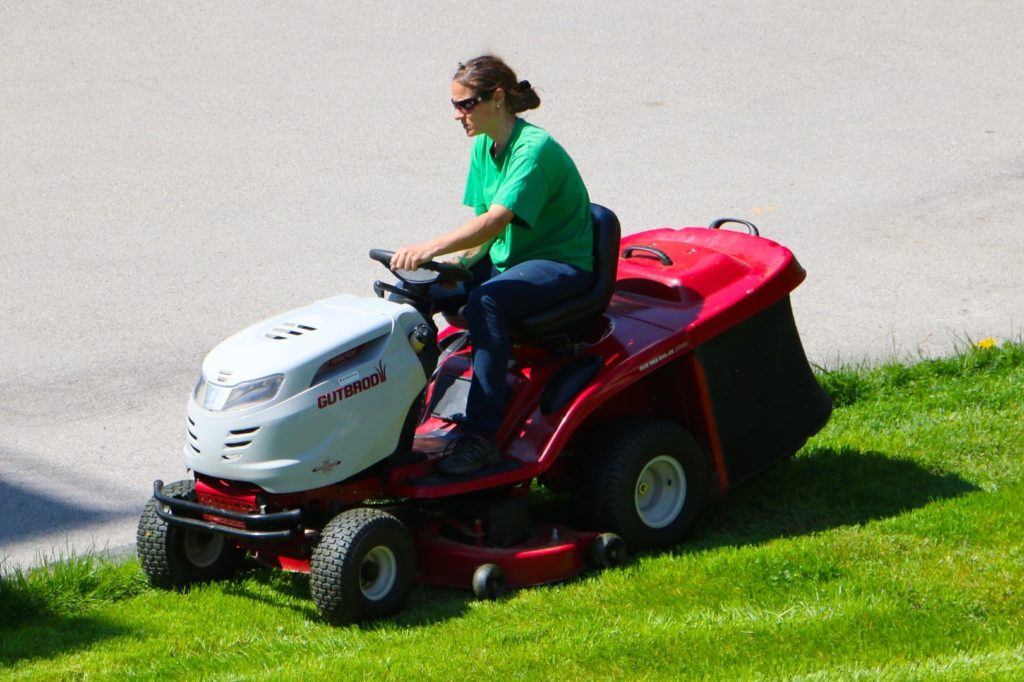Zero Turn vs. Riding Mower: Differences & Which is Better?
-
- Last updated:


If you have a lawn over ½ acre, you’ve probably already have made your mind up about your next lawnmower. It has to be a tractor. Using a self-propelled mower isn’t cutting it anymore. Besides, it takes too long and is too much work. That’s the easy part of the question. The next thing you have to consider is whether to invest in a zero-turn model or a regular riding mower.
Both zero turn and regular riding mowers have their pros and cons. Some of them fall into the dealbreaker/dealmaker category, which will make your decision easier. Our guide will consider the essential features that can help you make an informed choice. It’ll make mowing the lawn less of a drudgery, too.

Overview of Zero-Turn Riding Mower

The name, zero-turn riding mower, is something of a misnomer. It implies that it can’t turn at all. The reality is that it applies more to the turning radius than anything else. You can turn on a dime—literally! Well, almost, but you can make much tighter turns than you can with a conventional riding mower. These machines have dual-hydrostatic transmissions instead of the foot pedal or hand lever types you usually see.
The technology isn’t very old, with the first commercial products out in 1956. Inventor Max Swisher apparently didn’t like mowing the lawn any more than you do. While the design has taken a few turns along the way, it brings some compelling benefits to the table, as you’ll see.
How it Works
The dual-hydrostatic transmission means that you’re controlling the mower with two levers or a dual-bar instead of the usual steering wheel like you’d see in a car. Each one controls one of the rear wheels. This setup allows you to maneuver them separately so that you can make tight turns and follow curves in the lay of the land.
When to Choose It
The zero-turn riding mower comes into its own in yards with a lot of obstacles, whether they are trees, raised beds, or shrubbery. It can scoot around them and get a lot closer to the object. That leaves less weed-whacking to do after you finish mowing. That fact alone can save you time and labor, which are excellent points in favor of these machines.
Terrain
The zero-turn mower does best on flat ground. It can grip the surface and move along freely. The turning radius is well-suited to landscaping that includes a lot of curves. Using this type for your lawn can save you a lot of time without the reversing and maneuvering required with regular riding mowers. On the other hand, the latter is the better choice for uneven or hilly terrain.
Speed
Another advantage of the zero-turn mower is its speed. This puppy can cook with speeds up to 10 mph or more, depending on the model. That will save you time and get the job done quicker. However, it comes at a price that may negate these benefits. The faster you mow, the less likely you’ll get a perfectly trimmed lawn. That stipulation also applies to regular riding mowers, so it’s not necessarily a drawback.
Maneuverability
One of the glaring cons of a zero-turn mower is its maneuverability out of the gate. You will realize this fact straight away the first time you drive one. Suffice to say that there is a learning curve when using two levers. It may seem counterintuitive to push the left one further forward to go right. You’ll likely fall back on instinct and do the opposite the first few times.
That factor also comes into play with the terrain. You’ll have more control with a steering wheel than the two levers when you try to scale hills. We recommend that you hone your skills with driving forward before attempting uneven surfaces.
Functionality
The point may likely be a deciding factor for you, depending on how you plan on using your riding mower. Undoubtedly, it’s obvious that you can do more with a riding mower than cut grass. However, that’s the main purpose of these machines. They aren’t the best choice for hauling stuff or clearing your drive after a snowstorm.
You will see attachments for other tasks with zero-turn mowers. They’re just not as efficient at doing these side jobs as a regular riding mower. It’s due in part to the maneuverability and the design with its center of gravity.
Price
Price is also worth mentioning because you can expect to pay more with a zero-turn mower because of its design. Even a low-end model is going to set you back well over $1,000. Popping for a high-end product with all the bells and whistles can cost several thousand dollars and even dip into five figures for a commercial-grade mower.
- Faster speeds
- Outstanding maneuverability around obstacles
- Reduced lawn maintenance with other tasks like trimming
- Expensive
- Unsuitable for rugged or uneven terrain
- Limited functionality

Overview of Regular Riding Mower

Today’s riding mower seems like a luxurious vehicle, compared to the first push lawnmower invented in 1830 in the United Kingdom. It would take nearly 90 years later before the first modern examples hit the market. The models you see now are essentially smaller versions of farm tractors. They do many of the same types of things. Their most significant advantage is that they make shorter work of cutting the grass in large yards.
How it Works
A riding mower is essentially a down-sized vehicle with a small engine using manual transmission. They are similar to cars and trucks, down to the shared maintenance. Most operate using a steering wheel. Some even have acceleration and brake pedals, making it easy to use if you already know how to drive. Simply turn the key, and you’re ready to get to work.
When to Choose It
A riding mower is almost an essential device if you have a larger lawn. You’ll find a range of products that vary in the horsepower of the engine. The larger your yard, the bigger the motor you should get. You’ll see riders for both residential and commercial use. They work best if you have a lawn with few obstacles that you must maneuver around to get the job done.
Terrain
A riding mower has the power to drive up hills and traverse uneven surfaces without any problems. It is easier to use than a zero-turn model because you’ll have better control and traction with a steering wheel instead of two levers or a dual-bar.
Speed
A riding mower is not quite as fast as a zero-turn model. Its top speed hovers around 7 mph. It’s not necessarily a deciding factor unless you have a larger lawn and want to get the mowing done as quickly as possible. Nevertheless, you’re talking about a 40-percent or more increase. However, the same caution about a clean lawn and speed still applies.
Maneuverability

A regular riding mower has a distinct advantage over a zero-turn model. There is virtually no learning curve. The operation is simple because it’s intuitive to drivers. The downside is that you have a wide radius from which you can turn. That can make it difficult to maneuver around trees and other obstacles in your yard. If you don’t judge it correctly, you’ll end up reversing and driving around more to cover the same ground.
Functionality
If something is going to sway you to choose a zero-turn versus a regular riding mower, it is the accessories and attachments you can use with the latter. It’s a worthwhile consideration when you think about the up-front cost of either one. You can get year-round functionality if you use it more than the 25–35 times you would mowing your yard if you live in the northern Midwest.
You can attach a trailer for hauling plants to your garden or mulch around your shrubbery. You can do other landscaping tasks, such as aerating or fertilizing your lawn. If you get a plow attachment, you can clear your drive yourself and save the expense of hiring a service. That leads us to our final point.
Price
An entry-level riding mower will cost a bit less than a zero-turn with its advanced technology. Even higher-end models are still more affordable than a comparable zero turn. You should balance the price with the product’s usability. If you can use one mower year-round, that makes it a more practical purchase when you think about the money you’re saving by hiring someone or renting another device.
- Functionality
- Better ROI
- Ideal for uneven or hilly terrain
- More affordably priced
- Inability to maneuver around obstacles easily
- Slower speeds

Buyer’s Guide
The basics of buying a zero-turn or riding mower are similar. There are practical issues of engine size, the number of blades, cut height, and comfort. However, there are a few points worth noting that affect the usability of one type over another that you should know before buying any riding mower.
Deck Size
The deck is the business end of a mower. It determines how wide of a swath you’ll cut with each pass. Most start at 42” wide and go up from there. A regular riding mower can accommodate ones up to 54” whereas a zero-turn model can reach 60”. However, it’s not as much about how wide the deck is as it is the maneuverability of the mower.
It makes no sense to get a larger one for either type if the mower can’t mow your entire lawn, narrow spaces, and all. It defeats the advantages of getting a zero-turn. Bear in mind that if the tightest squeeze is between plants, it’ll likely change. On the other hand, if your lawn is more like a wide-open park, go with the wider deck to take advantage of the time-saving factor.
Maintenance
If both mowers are gas-powered, the maintenance is virtually identical. You’ll still have to stabilize the fuel every winter. Oil changes are still on the agenda. The blades will need sharpening, too. The fact remains that getting the most out of your purchase means routine care no matter which lawnmower you get. We suggest following the manufacturer’s recommendations and make proper maintenance a priority.
Guarantee/Warranty
Most manufacturers will at least offer a money-back guarantee for defects. However, we prefer products that come with a multi-year warranty if just because of the cost of buying a riding mower. We recommend reading the fine print with any terms or conditions. Regular maintenance is typically something you’ll see.
Safety
Safety is of paramount importance, no matter which mower you get. Over 90,000 people get injured each year using lawnmowers. We recommend that only adults use a zero-turn mower because of the higher learning curve to operate the device. While the regular riding mower can handle hills, do not attempt to scale any with a 15-degree or more incline. There’s a reason that riders top push mowers with accidents.
Which is Right for You?
The question of which model to get ultimately rests with your landscaping and terrain. If your lawn is flat with many obstacles, the zero-turn mower is your best bet. It will save you time and money in the long run. On the other hand, opt for a regular rider if your yard is open. You can still take advantage of the other benefits that it offers with functionality.
- Flat terrain
- Lawns with lots of landscaping
- Speed
- Hilly terrain
- Open spaces
- Speed is not an issue
- Functionality

Conclusion
Both zero-turn and regular riding mowers offer homeowners an excellent way to keep their larger lawns healthy and looking their best with regular maintenance. Using these machines is easy, too, making the choice to buy one a no-brainer. The essential thing is to consider your landscaping and what projects you want to add in the future. Either way, you’ll have a mower that can make your job easy-peasy.
Contents

